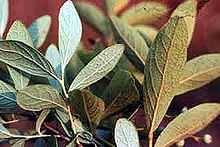Gaylussacia frondosa
| Gaylussacia frondosa | |
|---|---|
 | |
| Conservation status | |
| Scientific classification | |
| Kingdom: | Plantae |
| (unranked): | Angiosperms |
| (unranked): | Eudicots |
| (unranked): | Asterids |
| Order: | Ericales |
| Family: | Ericaceae |
| Genus: | Gaylussacia |
| Species: | G. frondosa |
| Binomial name | |
| Gaylussacia frondosa (L.) Torr. & A.Gray ex Torr. | |
Gaylussacia frondosa is a species of flowering plant in the heath family known by the common names dangleberry, hairy dangleberry, and blue huckleberry. It is native to the eastern United States, where it occurs from New Hampshire to South Carolina.[1]
This shrub grows up to two meters tall. The plant spreads via rhizome, sprouting up new stems to form colonies. The leaves are up to 6 centimeters long by 3 wide. They are hairy and glandular. The inflorescence contains 1 to 4 flowers that hang on pedicels up to 2 centimeters long. The flower is bell-shaped and greenish white in color. The fruit is a juicy, sweet-tasting drupe which is usually blue but may be black or white.[1]
This plant grows on the Atlantic coastal plain. It grows in wooded areas and next to bogs and swamps. It is common in the pine barrens of New Jersey. It grows on acidic soils low in nutrients. It grows with other related plants such as highbush cranberry (Vaccinium corymbosum), hillside blueberry (V. pallidum), Lyonia spp., sheep-laurel (Kalmia angustifolia), wintergreen (Gaultheria procumbens), dwarf huckleberry (Gaylussacia dumosa), and black huckleberry (G. baccata).[2]
Many animals eat the berries and disperse the seeds.[2]
Taxonomy
Gaylussacia frondosa was once more widely circumscribed, encompassing three varieties; however, G. frondosa var. nana and G. frondosa var. tomentosa are now widely recognized at species level, as Gaylussacia nana and Gaylussacia tomentosa.[1]
